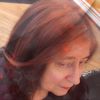Emotional Numbness: curators after my own heart
I am so in awe of the curators Atefeh Khas and Minoosh Zomorodinia of this exhibition. Their thoroughness and dedication to accessibility of these works deserves all of our gratitude and appreciation.

I am so in awe of the curators Atefeh Khas and Minoosh Zomorodinia of this exhibition. Their thoroughness and dedication to accessibility of these works deserves all of our gratitude and appreciation.
Here is the 360VR tour at Platform3 in Tehran. Currently you can still view this online.
The online exhibition which contains all the art in this show is extended through January 2021. This includes work that was not able to be exhibited at Platform3. So these multiple links are not really redundant.
Photos from opening reception in Tehran can be found here .
The booklets in Farsi and English here .
Conversation Between Curators, of their exhibition, Emotional Numbness: The impact of war on the human psyche and ecosystems, features Atefeh Khas in Iran and Minoosh Zomorodinia in Oakland.
This show was curated by 2 Iranian curators, one in Tehran, one currently in Oakland CA, through Women Eco Artists Dialog, also in Oakland. Most of the work that appears at Platform3, the actual space in Tehran, is made by Iranian artists and a few made by those of us from the US who sent work to the gallery. It’s not just the pandemic, but obviously the diplomatic situation as well that posed challenges to this exhibition. The curators took a big risk that the logistics might not be possible, and they acknowledged considerable technical support from WEAD.
One reason for the additional virtual exhibition via Kunstmatrix is to include more art that couldn’t travel (a major reason was expense, and some confusion about customs rules sent a couple of back). Having sent art and books to and from Korea various ways, I learned a bit about art shipping for exhibition. Most countries have duties and protocols about the importing of artworks because they presume they will be for sale or, in the case of Korea, to be published for profit. These duties can be very steep and when work goes by ship, they require quarantine. I had my imagers at Art & Soul make a giclée print, due to cost (which was still expensive), at slightly reduced size but still legible, and I sent this reproduction to Platform3 (see next post, A Postal Journey). And actually my helper USPS worker in Ballard also assisted me with ways to reduce the shipping cost and with completing the forms identifying that the value of the work shoul be low but not zero. My success prompted me to save the tracking pages in A Postal Journey. These took place when the post office was struggling with domestic political manipulation. I was curious to see whether it would ever get to Platform3.
Visitors were still coming to see the Platform3 exhibition at the end of September. Over 150 visitors came to the opening in Tehran. WEAD's board is pleased with the result: the message is PEACE and was a great success. At this time when the White House is saber rattling threats to Iran and the international community while failing to honor exquisitely negotiated peace and disarmament treaties, sharing friendship across borders throughout the world becomes more important than ever.
I hope you enjoy both the virtual exhibition and view the visit to the beautiful Platform3 space. This online approach is the first for me. WEAD produced one earlier this year for shows in California, near Sacramento when the pandemic started (ones I’d planned to see). The art world promised this technology when the worldwide web began to take hold. We had hoped to share our work around the world. But little has been done until this year to expand acceptance and distribution. So glad this is one benefit of shutdown.

Here's a link to the wead.artists Instagram account here.
Aside from the opportunity to show a work I had taken to Korea in 2012, I was thrilled for the opportunity to exhibit work in Tehran. As an undergrad in 1971 I took an anthropology class in Folklore at UCSC and my project paper was a collection of songs I made and a discussion (attempted structuralist analysis) of these. I collected songs from International students from Iran who were studying at UC Berkeley. They were socialist in their politics and with the Shah in power, couldn’t go home. I recorded them and their songs, copied the words in Farsi and they translated them into English for me.
These were songs from Iran that students sang when they got together and one of them had a “socialist” verse about their hopes to have revolution when they could go home in the future. I have no idea whether they did return when the revolution of 1979 began in 1977, but I imagine they did. I don't know their ultimate fate.
Then when my husband Jim and I taught English during the 1980's at Santa Monica College, we had 1) wealthy scion of Shah’s class exiles and 2) professionals such as social workers and doctors who had never planned to leave their home but were worried about repression. So although I’ve never been there, I’ve had a great deal of sympathy for Iranians who can’t live in their country. The rich boys were spoiled; at the same time, they were homesick. The others, older, professionals, had tragic stories. and had to leave family members behind.
